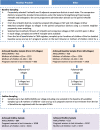Can digitally enabling community health and nutrition workers improve services delivery to pregnant women and mothers of infants? Quasi-experimental evidence from a national-scale nutrition programme in India
- PMID: 35835476
- PMCID: PMC9296874
- DOI: 10.1136/bmjgh-2021-007298
Can digitally enabling community health and nutrition workers improve services delivery to pregnant women and mothers of infants? Quasi-experimental evidence from a national-scale nutrition programme in India
Abstract
Background: India's 1.4 million community health and nutrition workers (CHNWs) serve 158 million beneficiaries under the Integrated Child Development Services (ICDS) programme. We assessed the impact of a data capture, decision support, and job-aid mobile app for the CHNWs on two primary outcomes-(1) timeliness of home visits and (2) appropriate counselling specific to the needs of pregnant women and mothers of children <12 months.
Methods: We used a quasi-experimental pair-matched controlled trial using repeated cross-sectional surveys to evaluate the intervention in Bihar and Madhya Pradesh (MP) separately using an intention-to-treat analysis. The study was powered to detect difference of 5-9 percentage points (pp) with type I error of 0.05 and type II error of 0.20 with endline sample of 6635 mothers of children <12 months and 2398 pregnant women from a panel of 841 villages.
Results: Among pregnant women and mothers of children <12 months, recall of counselling specific to the trimester of pregnancy or age of the child as per ICDS guidelines was higher in both MP (11.5pp (95% CI 7.0pp to 16.0pp)) and Bihar (8.0pp (95% CI 5.3pp to 10.7pp)). Significant differences were observed in the proportion of mothers of children <12 months receiving adequate number of home visits as per ICDS guidelines (MP 8.3pp (95% CI 4.1pp to 12.5pp), Bihar: 7.9pp (95% CI 4.1pp to 11.6pp)). Coverage of children receiving growth monitoring increased in Bihar (22pp (95% CI 0.18 to 0.25)), but not in MP. No effects were observed on infant and young child feeding practices.
Conclusion: The at-scale app integrated with ICDS improved provision of services under the purview of CHNWs but not those that depended on systemic factors, and was relatively more effective when baseline levels of services were low. Overall, digitally enabling CHNWs can complement but not substitute efforts for strengthening health systems and addressing structural barriers.
Trial registration number: ISRCTN83902145.
Keywords: child health; health services research; health systems evaluation; maternal health; nutrition.
© Author(s) (or their employer(s)) 2022. Re-use permitted under CC BY. Published by BMJ.
Conflict of interest statement
Competing interests: None declared.
Figures





References
Publication types
MeSH terms
Associated data
LinkOut - more resources
Full Text Sources
Miscellaneous
